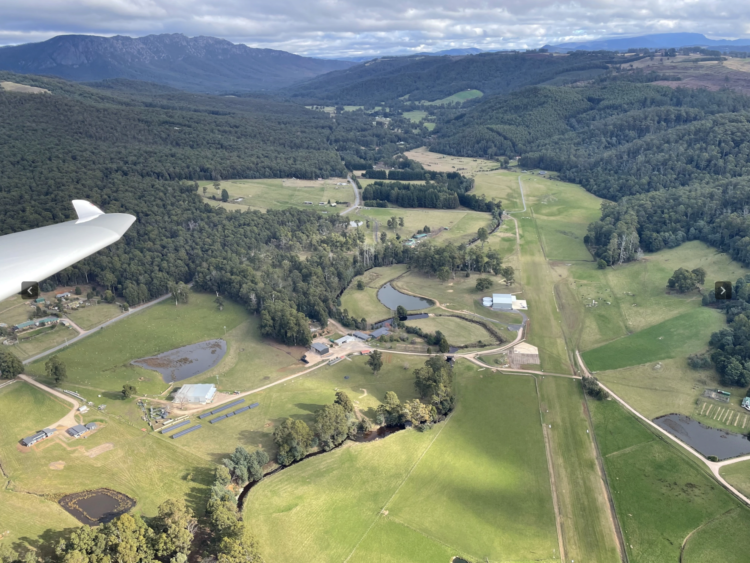
Simon Hackett is aiming to make his 170 acre Tasmanian estate energy self-sufficient. There are a number of dwellings; outbuildings; farm sheds for sheep and cattle farming; electric vehicles – and, unusually, an electric-motor powered self-launching glider, which he flies from his own runway.
Simon is the architect behind the Redflow Battery Management System. Redflow manufacture modular ZBM2 zinc bromine batteries – 10kWh units which can be cycled 100% in harsh conditions. Twenty-eight of them (280kWh) provide the energy storage for Simon’s own system.
System Components
- Three-phase grid feed via a 500kVA transformer (configured for up to 200kWp export)
- 266 x LG 375W panels provide 100kWp. (Additional 100kWp solar array under construction)
- 4 x 25kWp Fronius Symo AC Inverters
- 12 x Victron Quattro 48/15000 totalling 180 kVA
- 28 x 10kWh Redflow ZBM2 zinc-bromine energy storage modules totalling 280 kWh
- Cerbo GX system controller interfaced to 3 x Redflow Battery Management System units
- Underground sub-main distribution system servicing houses, farm buildings and an aircraft hangar
- Underground site-wide single-mode optical fibre network serving site-wide indoor and outdoor WiFi access points and networked access control and building management systems
- Provision for generator
The system was installed by DMS Energy of Tasmania. Simon says it looks great and works brilliantly. Here he tells us about his system and its performance:
Flow Batteries
The system stores surplus energy in Redflow Zinc-Bromine flow batteries. These batteries have a lot of advantages compared to Lithium batteries, for stationary energy storage applications such as this one.
System Performance and Future Plans
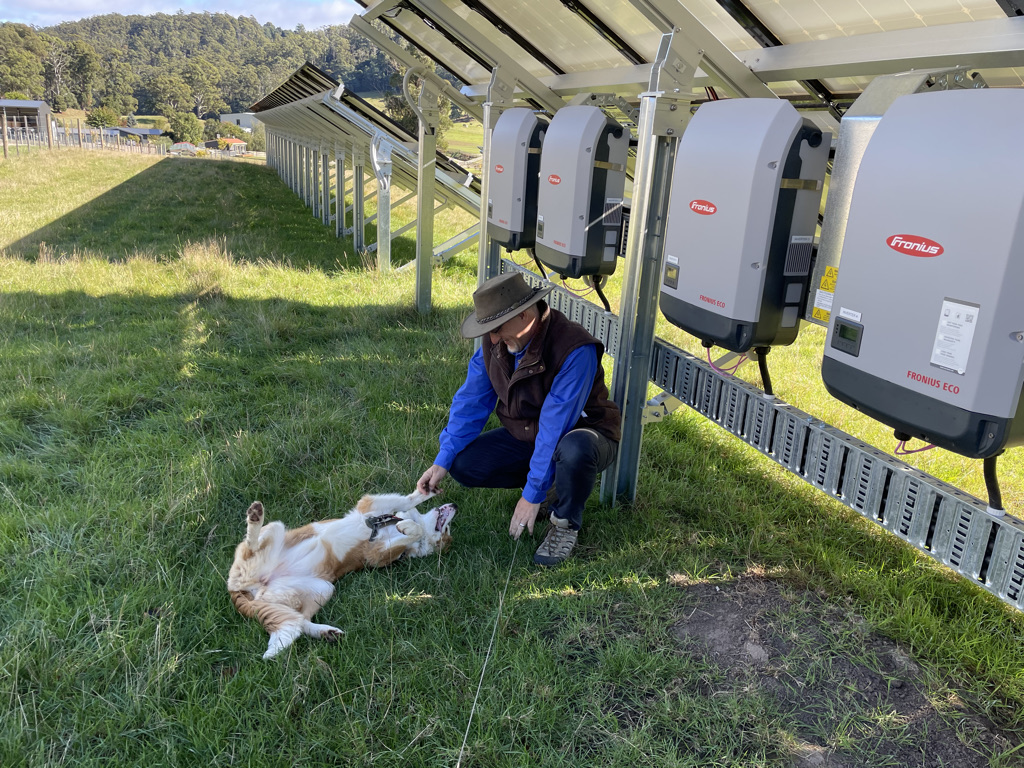
We decided to deploy a relatively large solar array with the aim of obtaining adequate overall performance in the winter months. Our panels are also our renewable transport fuel station for a Tesla Model S sedan; a Polaris ‘Ranger’ electric ATV; and an electric aircraft.
Our plan is to progressively eliminate the use of diesel by running electric 4WD vehicles, tractors, and excavators as they become available in Australia. The beauty of the large on-site solar array is that all of these vehicles can be charging when they are not being driven.
During this winter, typically, we manage to half-fill the battery array – which lasts about half the night before grid energy is required. Doubling the solar array should allow us to supply all energy demands on most days without drawing any grid energy.
In the summer we’ll be exporting plenty of energy – and being paid to do so.
Here are some (summer time) screen shots from the on-site control system and from the outstanding Victron Remote Management (VRM) data logging portal.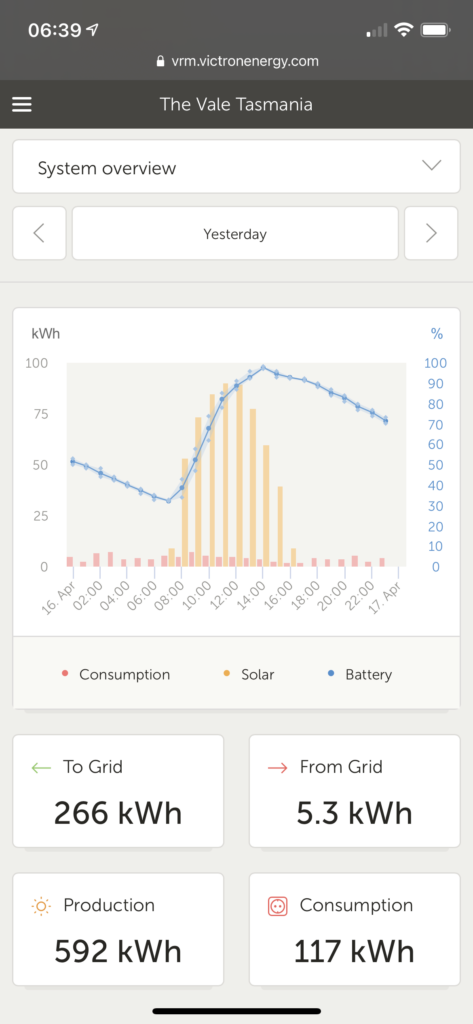
On VRM you can see the solar array producing more than 90kW, the battery bank was mostly full with a tapered charge-rate, and plenty of solar energy was being exported to the grid.
The ‘System Overview’ and ‘Consumption’ charts show the battery ending the day pretty much full, the site ran all night on ‘stored sunshine’ and started the following day half-full.
We exported plenty of green energy to our neighbours and we used practically no energy from the grid.
Once all our vehicles are electric our total export energy will be less, but that will be more than offset by savings on diesel – and we won’t be emitting CO2 or Diesel particulates.
On-site Energy Efficiency
All the houses on the farm are heated/cooled using heat pumps. This is the most efficient way to do it, by far, and it’s often poorly understood just how much more efficient a heat pump is than other cooling/heating systems.
A heat pump doesn’t create heat – it moves heat energy from the outside environment into the house (or vice versa, to cool it). Typically, 3-4 kilowatts of heating or cooling are gained for each kilowatt of energy used by the heat pump.
We have a Spa pool which need a fair bit of energy to keep hot, and we have done two things to minimise that energy draw.
First, we have used a Spa heat pump to do the water heating, offering similar efficiency to the heat pumps.
Second, we have installed a monitoring and control device so we can remotely control it – turning the heating off when we are leaving home, and turning the heating back on before returning – so it’s nice and hot when we arrive.
We use a Sanden Heat Pump heat pump for domestic hot water – which performs really well.
On-site Energy Monitoring and Control
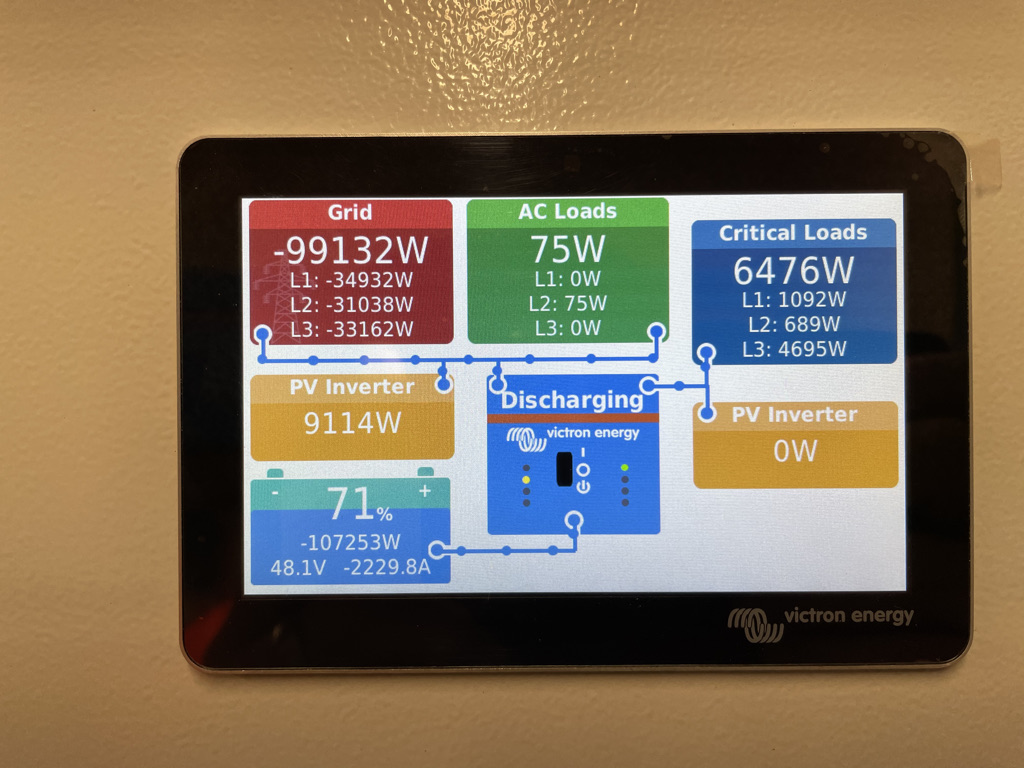
The key to optimising energy usage is to be able to measure it.
The Cerbo GX monitors all aspects of our renewable power plant in detail. This provides us with detailed evaluation of energy generation, storage, and consumption. We have a lot of separate buildings on the farm, and the key to understanding energy draw in each is provided by a number of Carlo Gavazzi EM24 ethernet interfaced energy meters so that energy usage can be narrowed down to each of these buildings with ease.
I am currently working on the design of a monitoring system to provide me with detailed analytics of where our energy is going on a per-building basis, and when.
We have deployed KNX based sensor and control devices around the property and plan to install more so that we’ll be able to control and optimise our energy consumption in a variety of useful ways. KNX is an extremely good way to implement building automation using a 30+ year old standardised protocol with full backwards compatibility, with support from over 500 hardware manufacturers.
With the upcoming enhancements in site monitoring and control, we expect to deepen our understanding of where energy is being used, to (in turn) allow us to further optimise that usage, using techniques as simple as moving various high energy demands to run ‘under the solar curve’ wherever possible. These are the times when on-site energy usage is essentially ‘free’ (avoiding the ‘energy round trip’ via the battery, and leaving more battery capacity for energy demands that cannot be time-shifted overnight)
In summary, our system is performing extremely well, and we are extremely pleased with it. When we have added even more solar, it will do even better.






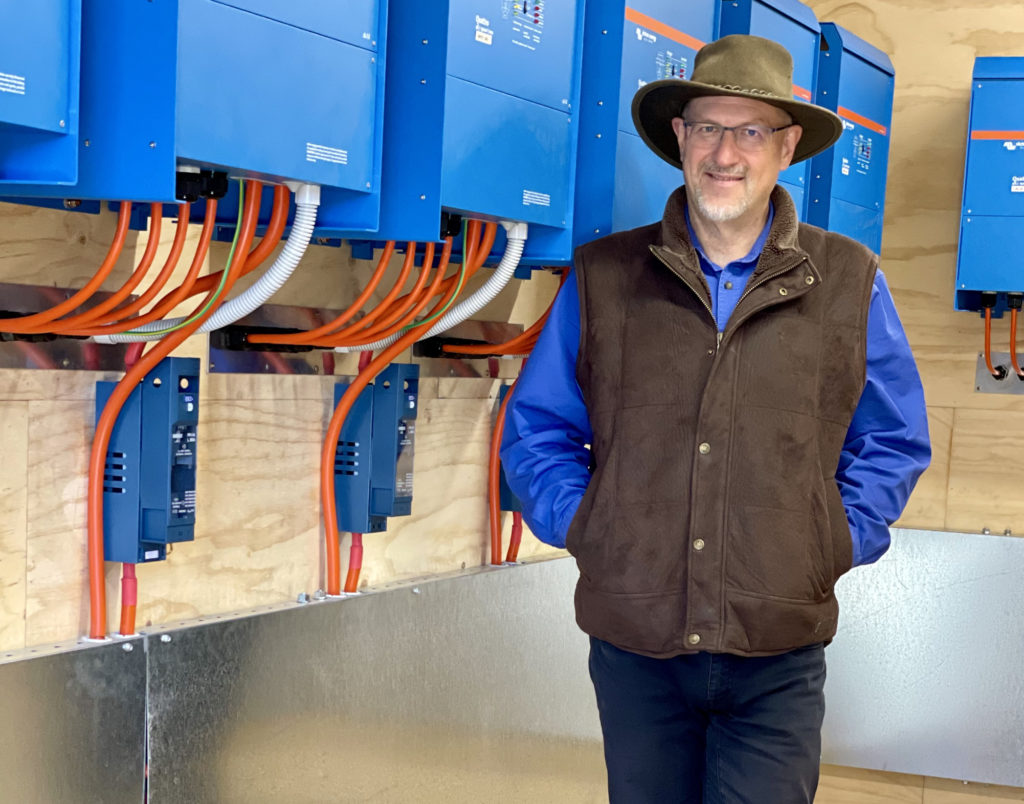
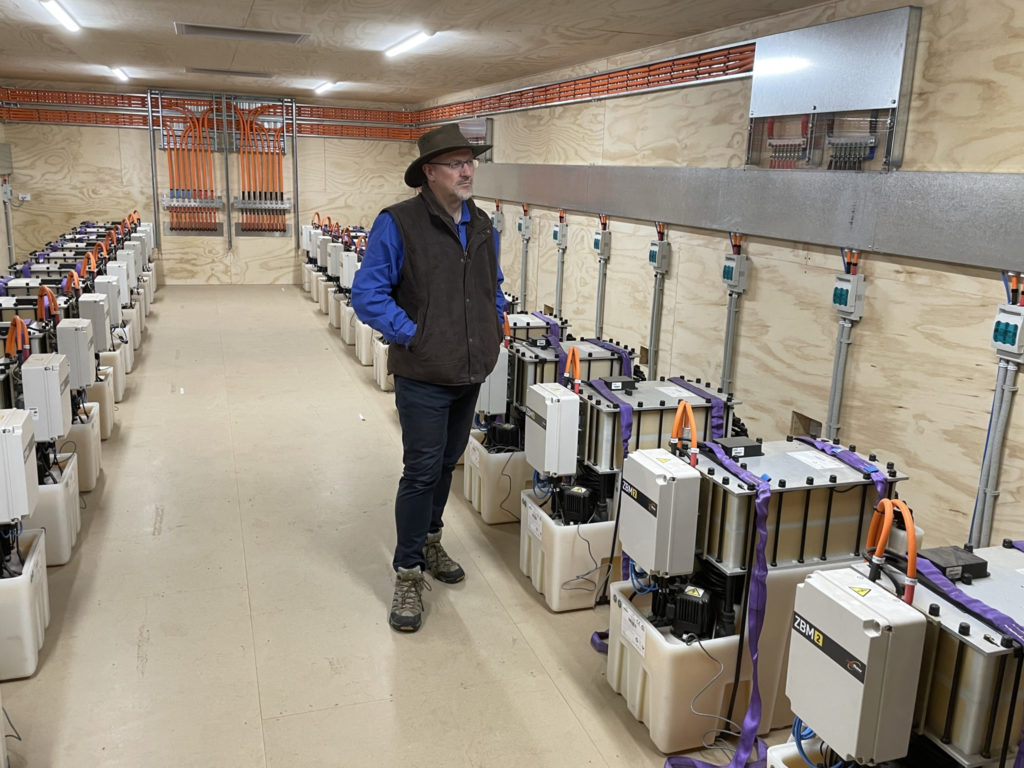
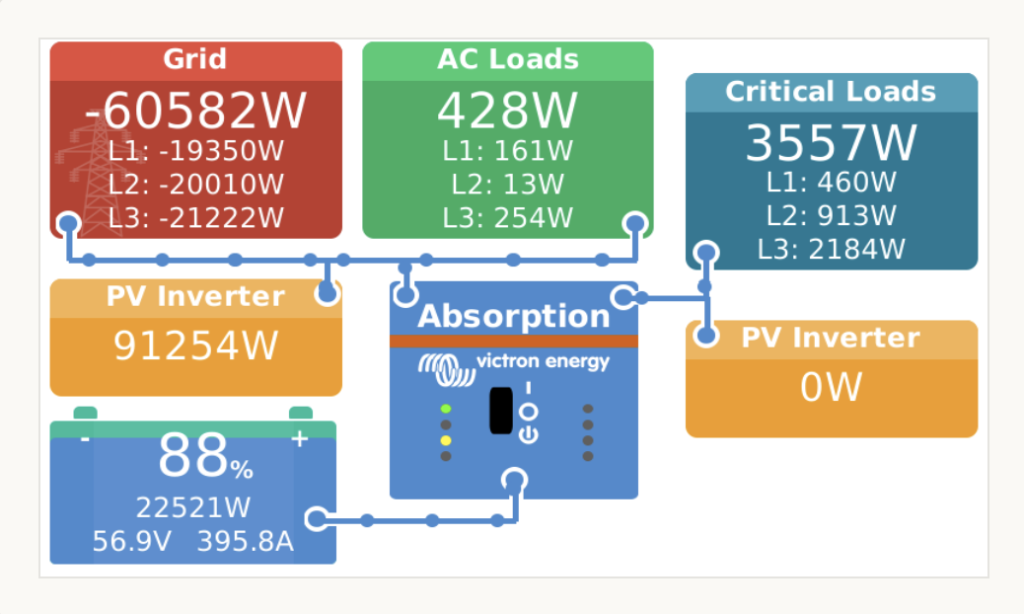
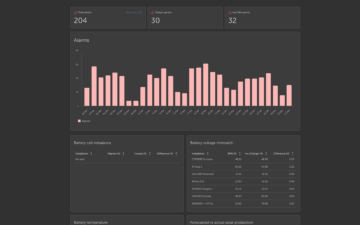
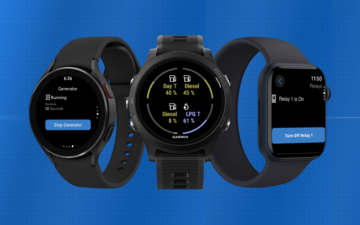
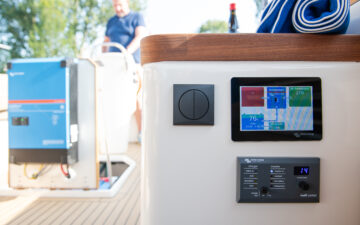









 #victronenergy #adventure
#victronenergy #adventure
 ELECTRICS
ELECTRICS 
